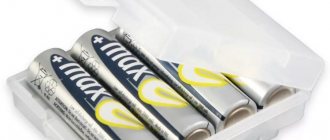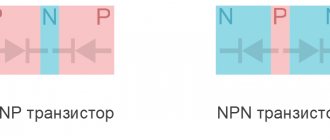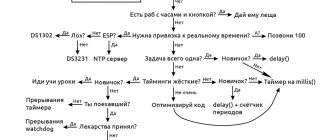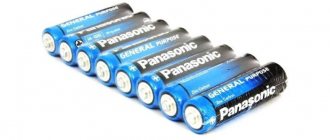Portable low power equipment is often powered by small dry galvanic cells that are not intended for recharging. In everyday life, such disposable chemical voltage sources are called batteries. AA and AAA batteries are popular. These letters indicate the external format of the battery. The internal structure can be completely different. This form factor produces various types of batteries, including rechargeable ones (batteries).
AAA battery is it finger or pinky?
The AAA battery is a pinky battery. Often, pinky and finger batteries are confused with each other due to their similar appearance.
Comparison of AAA and AA
AA batteries are slightly larger. On average, the length and diameter range from 14.5 millimeters, and the length from 50 to 50.5 millimeters. Little fingers are slightly smaller in size. In particular, their average diameter is about 10.5 millimeters, and their length does not exceed 44.5 millimeters. Weight about 14 grams. It is quite easy to confuse them in a store if a person is not an expert.
For an AAA battery, the positive electrode is a protrusion at the end of the product, and it occupies about a third of the diameter. The negative electrode is a flat or slightly raised area at the other end of the battery.
The batteries are protected against corrosion and short circuit. In particular, it is provided for this that the device is placed in a metal or plastic housing. Also protected is the insulation from the cylindrical electrode (positive for alkaline batteries and negative for salt batteries).
| Designation | A.A. | AAA |
| Labeling of salts | R6 | R03 |
| Alkaline labeling | LR6 | LR03 |
| Lithium marking | FR6 | FR03 |
| Height, mm | 50,5 | 44,5 |
| Diameter, mm | 14,5 | 10,5 |
| MIN capacity, mAh | 1100 | 540 |
| MAX capacity, mAh | 3500 | 1300 |
| Voltage, V | 1,5 | 1,5 |
Important! Attention should be paid to the product labeling to avoid later difficulties with returning or exchanging products.
Defining the terminology
First of all, let's define the terms. Those devices that we usually call “batteries” are galvanic cells - disposable sources of current. They cannot be charged: used them and threw them away. A battery, strictly speaking, consists of several elements connected in one way or another.
The photo on the left shows a 1.5 V galvanic cell, and on the right is a battery consisting of eight miniature galvanic cells. The latter are connected in series and placed in a housing of the same size. Its output voltage is 4.8 V. But it just so happens that all disposable power sources are called batteries, so we will also adhere to this terminology, while also using their real name - “galvanic cells”.
Batteries belong to a separate group of power sources. They can be charged and used repeatedly. One such element is called a battery, and several elements connected in one way or another are called a battery.
As you can see in the photo above, externally the batteries may not differ in any way from ordinary batteries. They can even be installed in the battery compartment of the appropriate format. That is why they are included in this article, where we will simply call both batteries and rechargeable batteries “accumulators”.
Types and characteristics of AAA batteries
Batteries marked AAA have differences. It is worth paying attention to this, since the type of anode and electrode installed changes the operating time, capacity and, as a result, the cost.
For all little finger batteries, the positive electrode is a protrusion at the end of the product, while it occupies dimensions of about a third of the diameter (indicated by a plus on the body). The negative electrode is a flat or slightly raised area on the other end of the battery (indicated by a minus). The dimensions are also the same for all, the weight will differ due to different production technologies.
Salt batteries
AAA R03 salt batteries appeared first of all, and they are still produced almost unchanged.
Saline AAA R03
The active mass of the positive electrode consists of manganese dioxide with acetylene black, electrolyte or flake graphite. The negative electrode is made of stable zinc with the inclusion of cadmium, lead or gallium. Differences:
- low cost;
- availability and low cost of raw materials for production;
- Ease of use;
- acceptable parameters of voltage and energy intensity for most modern electrical appliances.
Salt batteries are available to consumers primarily due to their low cost. But manufacturers are gradually abandoning their release, and there are several types of arguments for this. The disadvantages of salt batteries include:
- high degree of self-discharge;
- short service life - approximately two years;
- if there is an increase in discharge currents, then the level of energy intensity is significantly reduced;
- minimal activity when the ambient temperature drops.
Due to these characteristics, it cannot be said that salt batteries are in demand. They are not suitable for new gadgets, devices that require constant supply of the same energy, as well as a low self-discharge rate.
The battery has standard dimensions of 10.5 by 44.5 millimeters. The energy capacity reaches 540 mAh, which is the lowest among other types.
Alkaline batteries
AAA LR03 alkaline batteries use a zinc manganese battery. The electrolyte is an alkaline solution, the anode is powdered zinc, and the cathode is manganese dioxide.
Saline AAA LR03
Alkaline pinky batteries are more energy efficient and can withstand lower temperatures. The specific power of such batteries reaches 150 kW. The EMF of the battery is standard - about 1.5 Volts. The operating temperature range is wide compared to salt batteries - from -30 to +55 degrees. The dimensions are also standard - 10.5 by 44.5 millimeters. The energy capacity is large - from 1000 to 1100 mAh.
Benefits of alkaline batteries:
- high degree of energy intensity;
- low self-discharge coefficient;
- Ease of use.
But at the same time, alkaline batteries do not have a long service life. They also do not work well if the device for which they are intended requires surge voltage (the explanation can be found in the instructions).
Lithium batteries
AAA FR03 lithium batteries use lithium as the anode, cathode, and the electrolyte can have many types. Distinctive features:
- long operating time;
- high price.
Lithium batteries have the highest capacity - up to 1300 mAh, voltage 1.5v.
Saline AAA FR03
They are the most optimal, as they work with devices that require power supply continuously or intermittently. But at the same time, their cost is significantly higher than others.
Unclear markings
And finally, let’s talk about another type of marking that manufacturers love to decorate their products with. What do inscriptions like Power+, Turbo, Super, +40%, Long Lasting Power, Ultra and the like, which do not carry specifics, mean? What does "Ultra", "Super", "Turbo" or "++" on a battery mean? Never mind. Just an addition to the brand name. For example, Hong Kongers stopped diluting the electrolyte in their GP battery with donkey urine; a new model, GP Super, appeared. Or maybe they didn’t stop, they just tweaked something or added something.
Some inscriptions, of course, can be interpreted in some way if desired. For example, "Lasting Power" can mean high current output. Or it may not mean that. What does "Heavy Duty" mean? Heavy in what way? Are the currents large? Cold? Hot? Wet? Dry? Will they beat you? Or, on the contrary, do batteries create difficult conditions for the equipment they power?
Therefore, let us make it a rule - we read only what has an unambiguous and clear meaning. AA – clear and precise. LR03 - definitely. 1.5 V – of course. Duracell - no questions asked. Everything else is attributed to the development identifier and marketing, which do not promise anything and do not obligate the manufacturer to anything.
Where are AAA power supplies used?
The scope of use of AAA power supplies is large-scale.
They can be found in:
- wall clock;
- mobile gadgets;
- cameras and video cameras;
- mp3 players;
- remote controls;
- children's toys.
The scope of application is quite wide. In terms of popularity, little finger batteries are second only to finger batteries.
Distribution by form
Cylindrical batteries are the most common, but disk products are no less common. The classification according to form is as follows:
Classification by shape.
- R. From the English word “Round” - a round element. These are cylindrical models and “tablets”;
- P. Not round, rare;
- F. Flat, having a layer-by-layer structure;
- S. They look like a rectangular or prismatic platform.
Some products are available in every store, while others have to be looked for. Despite the abundance of options, they are classified according to standards. AA, AAA, B, C - the American standard, more familiar, so they usually adhere to it.
What to look for when choosing
The type of power supply determines its characteristics. Salt ones are the cheapest, but they no longer show sufficiently high current characteristics.
Lithium ones are high quality and reliable, but the price difference is big. The optimal choice is alkaline. They have a fairly high capacity, temperature range and reasonable cost.
Still have questions about the AAA Battery or have something to add? Then write to us about it in the comments, this will make the material more complete and accurate.
Popular manufacturers
There are dozens of manufacturers in the world, and all products are of high quality. The brands in the rating include Alkaline, Turbo max, Energy, Robiton, Minamoto.
Testing for operating time in minutes at the same load revealed the leaders:
Duracell ultrapower lasts 61 minutes of continuous use when tested.
- Duracell ultrapower - 61;
- GP - 56;
- "Trophy" - 53;
- Energizer - 44;
- Kodak - 40.
In terms of price-quality ratio, the most advantageous model is from.
Nickel metal hydride
Rechargeable batteries produced using this technology are designed to operate in non-standard temperature conditions.
The number of recharge cycles ranges from 600 to 800. But it should be noted that they will discharge somewhat faster compared to analogues operating in normal mode.
Traditional charging methods
When using the methods presented below, you need to remember that they can lead to negative consequences.
- If you are watching TV and suddenly the remote control stops working, then in this case you can remove the elements from the device and squeeze them with your teeth. This will restore the power supply for a short time. However, using this method, you can damage your teeth or get poisoned.
- Pour hot water into a container. The volume should be such that the power source is ½ of its size immersed in water. This process takes 25 minutes. After this time has expired, the device will start working.
- Take a phone charger that has a round attachment and a voltage of 5 v. Attach two wires to the tip in a cylindrical shape. Connect the first wire to the positive contact, and the second to the negative. But you need to know where the plus is and where the minus is, otherwise you will only make the situation worse. Connect the wires to the source in accordance with the polarity. Keep it this way until the element begins to seriously heat up. Therefore, you must carefully monitor the condition of the device, otherwise the battery will no longer function.
comparison table
The main differences between power supplies are shown in the table:
| AA | AAA |
| They are large in length and width. | They are more compact in size. |
| They have a longer service life. | They break down faster. |
| Used for large toys and other equipment. | Used in more compact and portable devices. |











